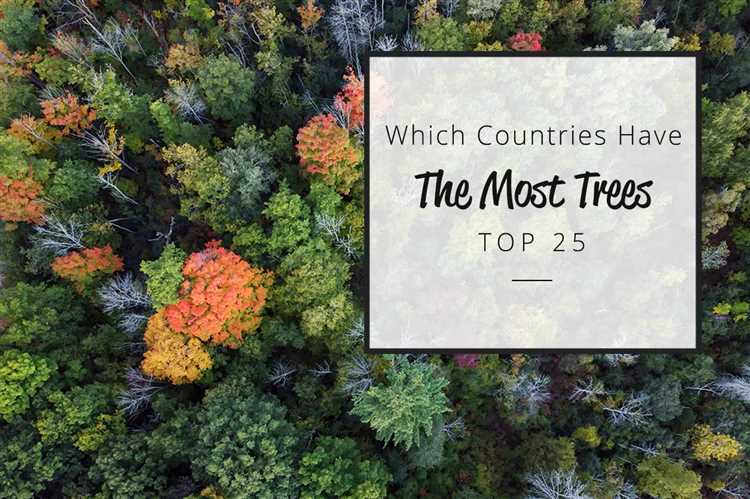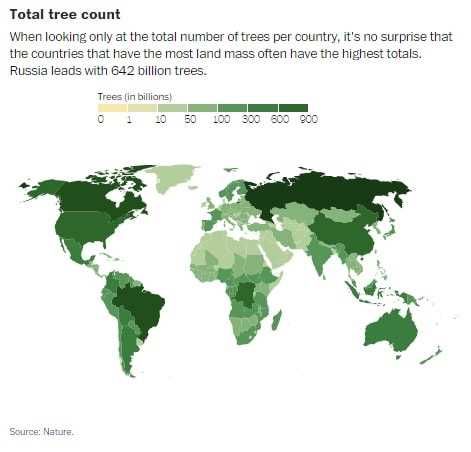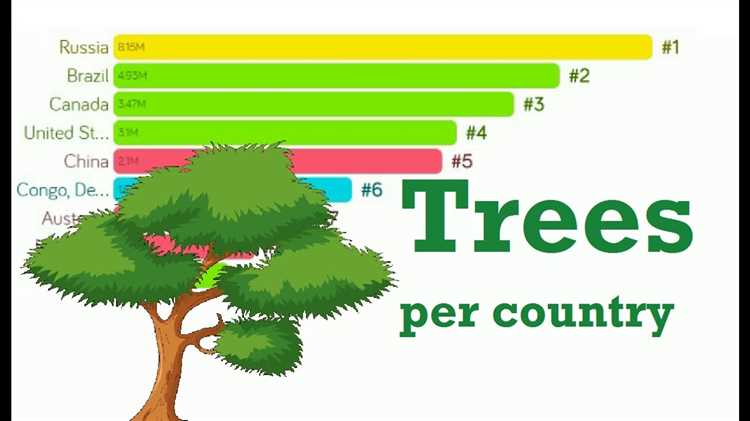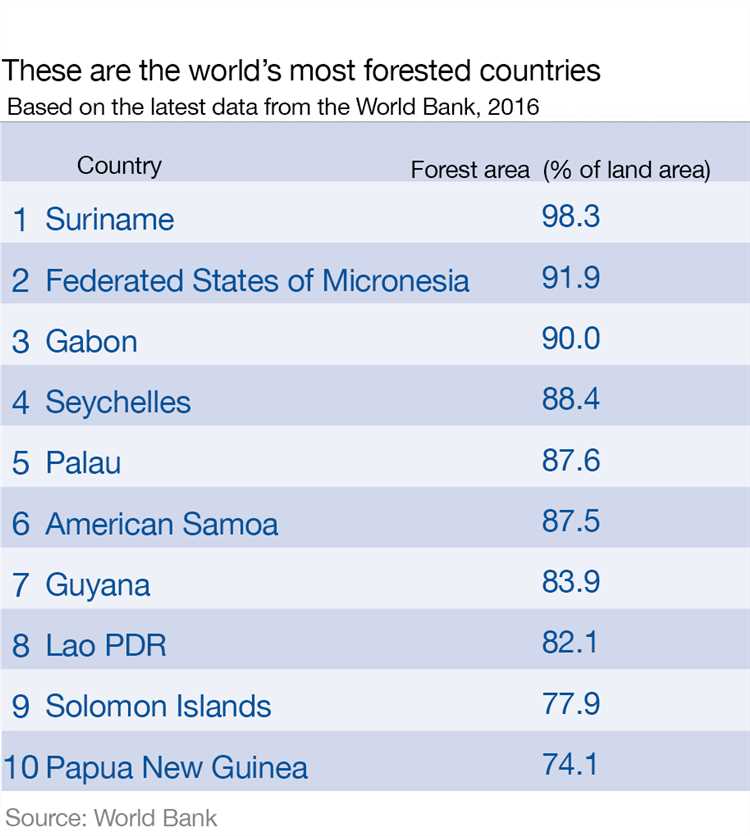
When it comes to counting trees, one country stands out above all others – Russia. Known for its vast and diverse landscapes, Russia holds the title for having the highest number of trees in the world. With its immense forests covering approximately 49% of the country’s total land area, it is no wonder that Russia is considered the tree capital of the world.
Russia’s forests are not only plentiful but also incredibly diverse. They are home to over 200 tree species, including the iconic Siberian fir, Scots pine, and Silver birch. These forests provide habitat for numerous animals and play a crucial role in maintaining the country’s biodiversity and ecological balance.
The importance of trees in Russia goes beyond their environmental benefits. The country’s abundant forest resources have played a significant role in its history and economy. For centuries, timber has been a vital source of income and a driving force behind Russia’s development. Today, the forestry industry continues to thrive, contributing to the country’s economic growth and providing jobs for millions of people.
With its impressive number of trees, Russia has not only earned the title of the country with the highest number of trees but has also become a symbol of the vital role that forests play in our world. As we continue to face environmental challenges, preserving and protecting these precious natural resources is more important than ever, and Russia serves as an inspiring example to us all.
- The country boasting the highest number of trees
- The role of trees in maintaining a healthy ecosystem
- Factors contributing to the country’s abundance of trees
- 1. Climate and weather conditions
- 2. Rich diversity of ecosystems
- 3. Government policies and conservation efforts
- The impact of deforestation on the country’s tree population
- Efforts to preserve and protect the country’s forests
- 1. Reforestation programs
- 2. Strict regulations and enforcement
- 3. Community involvement and education
- 4. Protected areas and national parks
- Benefits of the country’s extensive tree coverage
- Lessons to learn from the country’s success in tree conservation
- Question and answer:
- What country has the highest number of trees?
- How many trees does Russia have?
- Which country has the most forested land?
- Why does Russia have so many trees?
- What are the benefits of having a large number of trees?
The country boasting the highest number of trees
When it comes to lush forests and thriving greenery, there is one country that stands above all others. With its vast expanses of woodland, diverse ecosystems, and strong commitment to conservation, this country is truly a nature lover’s paradise.
That country is Canada. Known for its stunning landscapes and breathtaking natural beauty, Canada is home to an estimated 318 billion trees, making it the country with the highest number of trees in the world.
Stretching from the Atlantic to the Pacific and from the Arctic Circle to the United States border, Canada’s vast landmass encompasses a variety of ecosystems and climates. From the temperate rainforests of the Pacific Northwest to the boreal forests of the North, the country’s forests are teeming with life.
These forests play a vital role in mitigating climate change by absorbing carbon dioxide and releasing oxygen. They provide habitat for countless species of plants and animals, many of which are endemic to Canada. Additionally, the forests offer recreational opportunities for Canadians and visitors alike, such as hiking, camping, and wildlife watching.
The Canadian government has implemented strict conservation measures to protect the country’s forests, including sustainable logging practices and the establishment of national parks and protected areas. These efforts ensure that future generations will be able to enjoy the beauty and benefits of Canada’s trees.
From coast to coast, Canada’s forests are a testament to the country’s commitment to preserving its natural heritage. With its abundance of trees and stunning landscapes, Canada truly is the country boasting the highest number of trees.
The role of trees in maintaining a healthy ecosystem
Trees play a crucial role in maintaining a healthy ecosystem. They are not just aesthetically pleasing, but also provide numerous benefits that are essential for the well-being of both humans and wildlife.
One of the main functions of trees is their ability to absorb carbon dioxide, a greenhouse gas, and release oxygen through the process of photosynthesis. This helps in reducing the level of carbon dioxide in the atmosphere and improves air quality. Additionally, trees act as natural air filters by trapping dust and absorbing pollutants, thereby reducing the risk of respiratory diseases.
Trees also play a key role in regulating temperature and reducing the effects of climate change. They provide shade that helps cool the surrounding areas, reducing the need for air conditioning. In urban areas, their presence helps prevent the “heat island” effect, where concrete and asphalt absorb and radiate heat, making cities much hotter than rural areas.
Furthermore, trees help in maintaining water quality by preventing erosion and filtering pollutants. Their extensive root systems stabilize the soil, reducing the risk of landslides and protecting water sources. Trees also help in replenishing groundwater by absorbing and storing rainwater, which is especially important in areas prone to drought.
Another important role of trees is their ability to provide habitats for a wide range of species. Forests are home to countless plants, animals, and insects, which rely on trees for food, shelter, and breeding. By preserving and restoring forests, we are ensuring the survival of many endangered species and maintaining biodiversity.
Finally, trees have a significant impact on the well-being of humans. Studies have shown that spending time in nature, such as forests or parks, has numerous health benefits, including reduced stress levels, improved mental clarity, and increased physical activity. The shade provided by trees also reduces the risk of skin cancer caused by excessive sun exposure.
In conclusion, trees are vital for maintaining a healthy ecosystem. Their ability to absorb carbon dioxide, regulate temperature, filter air and water, provide habitats, and improve human health highlights their importance. Preserving and planting trees is crucial for the well-being of our planet and future generations.
Factors contributing to the country’s abundance of trees
There are several key factors that contribute to the country’s abundance of trees:
1. Climate and weather conditions

The country’s climate and weather conditions play a crucial role in the abundance of trees. It has a moderate climate with ample rainfall throughout the year, creating a favorable environment for tree growth. The consistent rainfall provides sufficient water for trees, ensuring their health and survival.
2. Rich diversity of ecosystems
The country boasts a rich diversity of ecosystems, including forests, wetlands, mountains, and coastal areas. Each of these ecosystems provides a unique habitat for different species of trees. The variety of habitats allows for a wide range of tree species to thrive.
These ecosystems also support a rich biodiversity of plants and animals, creating a balanced and sustainable environment for trees to grow and flourish.
3. Government policies and conservation efforts
The country has implemented effective government policies and conservation efforts to protect its trees and natural resources. Strict regulations are in place to prevent deforestation and promote sustainable forestry practices.
The government has also established national parks and protected areas to ensure the preservation of forests and the diverse ecosystem they support. These conservation efforts help maintain the abundance of trees and ensure their future growth.
In addition, the government and local communities actively engage in tree planting initiatives and reforestation programs to restore and expand forest cover. These efforts help counterbalance any loss of trees and contribute to the overall abundance.
Overall, these factors combined contribute to the country’s impressive abundance of trees. The favorable climate and diverse ecosystems, along with government policies and conservation efforts, create an environment where trees can thrive and continue to be a vital part of the country’s natural landscape.
The impact of deforestation on the country’s tree population
Deforestation has had a significant impact on the tree population in the country with the highest number of trees. As trees are cut down to make way for agriculture, urbanization, and industrialization, the country’s tree population has been drastically reduced.
Agricultural expansion is one of the major causes of deforestation in this country. Large areas of forests are cleared to make room for crops and livestock. This deforestation not only eliminates the existing trees, but also prevents new trees from growing. Without trees, the soil becomes vulnerable to erosion and loses its fertility, which has a negative impact on agricultural productivity in the long run.
Urbanization and industrialization are also major drivers of deforestation. As cities expand and industries grow, more land is needed for infrastructure and residential purposes. This often results in the clearing of forests to make way for roads, buildings, and factories. The loss of trees in urban areas not only affects the aesthetic appeal of the cities but also contributes to the rise in air pollution and climate change, as trees are vital for absorbing carbon dioxide and producing oxygen.
Furthermore, deforestation leads to the loss of habitat for many animal species. Trees provide shelter and food for a diverse range of wildlife. When forests are destroyed, these animals are forced to seek new habitats or face the threat of extinction. The loss of biodiversity not only disrupts the delicate balance of ecosystems but also affects human well-being, as many communities rely on the resources and services provided by these ecosystems.
Efforts to combat deforestation and protect the country’s tree population have been made, including the implementation of reforestation programs and stricter regulations on logging and land-use practices. Reforestation involves planting new trees in areas that have been deforested, with the aim of restoring the tree cover and ecosystem functions. These initiatives are crucial for preserving the country’s natural resources and mitigating the negative impacts of deforestation.
| Causes of Deforestation | Impacts |
|---|---|
| Agricultural expansion | Loss of trees and soil degradation |
| Urbanization and industrialization | Air pollution, climate change, and habitat loss |
| Loss of biodiversity | Disruption of ecosystems and impact on human well-being |
Efforts to preserve and protect the country’s forests
Preserving and protecting the country’s forests is of utmost importance to ensure the sustainability of its ecosystem and the wellbeing of its inhabitants. The government, along with various environmental organizations and local communities, has implemented several initiatives to safeguard these valuable natural resources.
1. Reforestation programs

One major effort to preserve and increase the country’s forest cover is through extensive reforestation programs. These initiatives involve planting trees in deforested areas and restoring degraded ecosystems. By planting a variety of tree species, these programs aim to restore biodiversity and recreate habitats for wildlife.
2. Strict regulations and enforcement

The government has implemented strict regulations to curb illegal logging and deforestation practices. Forest protection laws are in place to ensure that any cutting down of trees is done sustainably and with proper permits. Authorities carry out regular inspections and crackdowns on illegal logging activities, imposing heavy fines and penalties as a deterrent.
Additionally, the government promotes responsible forestry practices and encourages sustainable logging techniques, such as selective harvesting and reforestation after extraction.
3. Community involvement and education
Engaging local communities in forest conservation efforts is vital for long-term success. The government and environmental organizations collaborate with communities living near forests to raise awareness about the importance of protecting these valuable resources.
Community-led initiatives include training programs on sustainable forest management and income-generating activities that promote forest conservation. By involving the local population, these efforts help build a sense of ownership and responsibility towards the forests.
4. Protected areas and national parks
The establishment of protected areas and national parks is another measure to preserve the country’s forests. These areas serve as sanctuaries for rare and endangered species, providing them with safe habitats and protection from human activities.
- Strict regulations in these areas prohibit logging and other forms of resource extraction.
- Rangers and park officials patrol the protected areas to ensure compliance with the rules and to prevent illegal activities.
- Eco-tourism is promoted as a means to generate revenue for the management and protection of these areas.
By designating specific areas as protected, the government aims to conserve biodiversity and safeguard the country’s forests for future generations.
Benefits of the country’s extensive tree coverage
The country with the highest number of trees enjoys several benefits from its extensive tree coverage. These benefits include:
Conclusion: The country’s extensive tree coverage offers a wide array of benefits, ranging from environmental and biodiversity preservation to soil conservation, water regulation, and economic advantages. The commitment to maintaining and expanding the tree coverage should continue to be a priority for the country to reap the rewards for generations to come.
Lessons to learn from the country’s success in tree conservation
When it comes to tree conservation, there are several lessons that can be learned from the country with the highest number of trees. These lessons can serve as inspiration for other nations looking to improve their tree conservation efforts.
- Government commitment: The country’s success can be attributed to the strong commitment from the government to protect and preserve the trees. This commitment is reflected in the implementation of strict regulations and policies that ensure the sustainability of the forests.
- Community involvement: Another key lesson is the active involvement of local communities in tree conservation efforts. The government has encouraged and empowered communities to participate in activities such as tree planting, forest management, and education. This not only creates a sense of ownership but also ensures the long-term success of the conservation programs.
- Education and awareness: The country places a strong emphasis on educating its citizens about the importance of trees and forests. Through comprehensive education campaigns, people are made aware of the benefits trees provide, such as carbon sequestration, biodiversity conservation, and ecosystem services. This awareness fosters a culture of tree conservation and encourages individuals to take action.
- Partnerships and collaborations: Collaboration between various stakeholders, including government agencies, non-profit organizations, and private sector entities, has played a crucial role in the country’s success. Partnerships allow for the pooling of resources, expertise, and knowledge, leading to more effective and efficient tree conservation initiatives.
- Sustainable forestry practices: The country has adopted sustainable forestry practices, ensuring that the extraction of timber and other forest products is done in a responsible and environmentally-friendly manner. This approach promotes the regeneration of forests and minimizes the negative impact on ecosystems.
Overall, the success of the country in tree conservation can be attributed to a combination of strong government commitment, community involvement, education, partnerships, and sustainable practices. By adopting similar strategies and implementing effective policies, other countries can also make significant progress in tree conservation and contribute to the global efforts in combating deforestation and climate change.
Question and answer:
What country has the highest number of trees?
The country with the highest number of trees is Russia.
How many trees does Russia have?
It is estimated that Russia has around 642 billion trees.
Which country has the most forested land?
Russia also has the most forested land, covering about 45% of its territory.
Why does Russia have so many trees?
Russia’s vast size, diverse climate, and geographical features like the Taiga and Boreal forests contribute to the high number of trees in the country.
What are the benefits of having a large number of trees?
Having a large number of trees helps combat climate change, improve air quality, provide habitats for wildlife, and support various industries like timber, paper, and tourism.